Inside Matters
The gut health show – conversations with the most forward-thinking minds in health, fitness, science, nutrition and business. In-depth discussions about how our gut microbiome impacts our health, well-being, mood and more. Inside Matters was conceived by microbiome expert Dr James McIlroy as a platform to raise awareness of the importance of the gut microbiome. Our aim is to inspire and educate listeners around the world about the importance of gut health, equipping them with the knowledge they need to transform their lives for the better.
Episodes
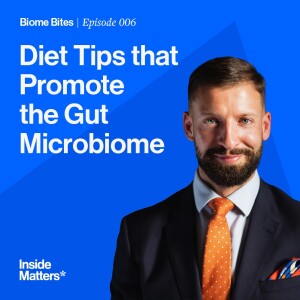
Thursday Jul 06, 2023
Thursday Jul 06, 2023
Listen to Inside Matters: https://insidematters.health/biome-bites
In this episode, Dr James McIlroy discusses diet tips to improve and fortify the gut microbiome. Touching upon topics such as the controversial argument surrounding artificial sugars, fermented foods and whole foods, and why some researchers believe that red wine can help to promote a healthy gut microbiome.
Just as a garden can be populated with weeds if the right conditions exist, so too can your gut microbiome with unhelpful habits and cravings. The broader picture goes back to:
- Reducing the number of harmful organisms in your system.
- Replacing lost microorganisms that are beneficial to your microbiome.
- And continuing to nourish the microbiome with a minimally processed diverse diet.
Timestamps -
00:00:00 Intro
00:00:46 What is the microbiome?
00:02:18 Key Points on Why Diet is Important for Microbiome Diversity
00:04:51 The Broader Picture When it comes to Gut Microbiome and Diet
00:05:40 Avoiding Artificial Sweeteners
00:07:45 Reducing Alcohol Intake
00:10:24 The Gut-Liver Connection
00:11:31 The Impact of Smoking on the Gut Microbiome
00:12:48 Episode Recap and Important Takeaway Points
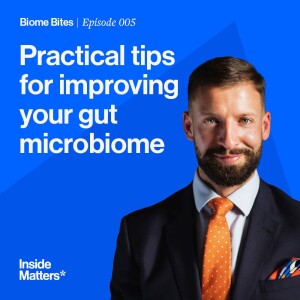
Thursday Jun 22, 2023
Thursday Jun 22, 2023
In this episode of Biome Bites, Dr James McIlroy explores some practical tips for improving your microbiome based on 3 specific areas:
Probiotics: what they are, where to find them and whether you should spend money on supplements or not
Prebiotics: what they are, where to find them and how to include them as part of your daily dietary intake
Polyphenols
James delves into how microbial imbalances occur within our bodies and what we can do to address these through diet and lifestyle.
James references David Sinclair’s podcast “Lifespan”, which you can learn more about here - https://www.lifespanpodcast.com/ and also Dr Hyman’s podcast “The Doctor’s Farmacy”, which you can find here - https://drhyman.com/blog/category/podcasts/
00:00:00 Intro
00:00:43 What is the microbiome?
00:01:54 You’re more microbial than human
00:02:12 Body’s microbial composition
00:02:41 How microbial imbalance occurs
00:03:23 How to achieve a healthy microbiome
00:04:56 Role of probiotics
00:05:57 Importance of probiotic foods
00:07:09 Role of prebiotics
00:10:10 You must stay hydrated!
00:10:32 The role of polyphenols
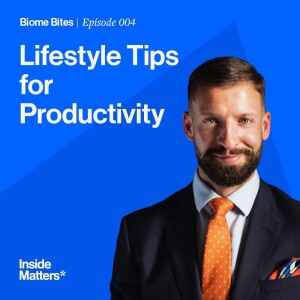
Thursday Jun 08, 2023
Thursday Jun 08, 2023
Dr James McIlroy shares some tips and tricks that keep him consistently productive throughout the day. Stacking up small wins, like pre-booking dentist appointments and haircuts months in advance to reduce stress. Investing in pill boxes for supplements and dried greens for on-the-go. With daily exercise, and the benefits this has on concentration and health that this naturally brings.
00:00:00 Introduction and welcome
00:00:21 - Batch Booking and Scheduling
00:01:53 - Buying the Essentials in Bulk
00:02:50 - Systems for Supplements
00:04:04 - Investing in a Pill Pack
00:05:00 - Sachets of Dried Greens
00:05:49 - Exercising Everday
00:08:08 - Episode Recap and Outro
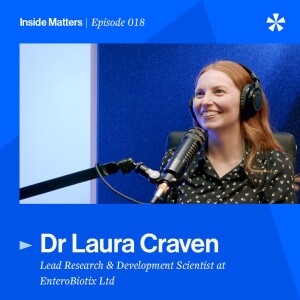
Thursday May 25, 2023
Thursday May 25, 2023
Dr Laura Craven is Lead Research & Development Scientist at EnteroBiotix and has a PhD in Microbiology and Immunology, specialising in gut microbiome modulation.
Dr Craven’s studies include research into the gut's role in auto-immune diseases like MS.
In this episode, Dr Craven joins James to discuss her journey from completing her PhD in Canada and the impact the NEMJ’s paper on Duodenal Infusion of Donor Feces for Recurrent Clostridium difficile” had on her science career, along with her own personal health diagnosis of Type 1 diabetes.
They chat about the difference between FMT and IMT, leaky gut syndrome and the factors, including stress, which play a part in us developing this challenging condition. And they broach the topics of probiotics, improving gut permeability, and whether having a morning coffee is actually a good idea.
Timestamps:
00:00:00 intro
00:00:29 getting into the field of the microbiome?
00:01:45 impact of the NEMJ paper
00:03:10 what was Dr Craven’s PhD on?
00:05:33 what’s the difference between “FMT” & “IMT”?
00:08:51 treating NAFLD with FMT
00:14:23 Enterobiotix and staff dietary provisions
00:16:18 Dr Craven discusses leaky gut syndrome
00:18:06 Wim Hof being injected with bacterial endotoxins
00:20:35 more discussion on leaky gut
00:21:22 getting a strong gut rather than a leaky one
00:22:26 How do doctors diagnose leaky gut?
00:24:06 how does FMT/IMT have an impact on leaky gut?
00:26:22 Dr Craven's study findings in relation to treating NAFLD
00:27:32 discussion around endogenous alcohol production
00:31:12 how has the public’s perception of FMT/IMT changed
00:34:14 gut permeability can be improved via FMT
00:37:41 treating MS with FMT/IMT
00:38:51 what factors cause leaky guy and what's the role of stress?
00:41:48 the connection between leaky guy and autoimmune diseases
00:44:10 what is a probiotic?
00:47:15 Dr Craven's move from Canada to Scotland
00:54:45 living with Type 1 diabetes
00:57:58 how do I improve my gut health?
01:10:32 hopes for diabetes and the role of FMT/IMT
01:20:04 is having a morning coffee a good idea?
01:21:18 where is the microbiome field heading in the future?
01:25:57 interaction between the microbiome and the host
01:26:54 what is engraftment?
01:32:13 what's FMT/IMT going to be used for next?
01:35:08 dietary challenges upon moving to Scotland
01:37:38 other scientific interests outside of the microbiome
01:39:14 the potential role of AI for health management
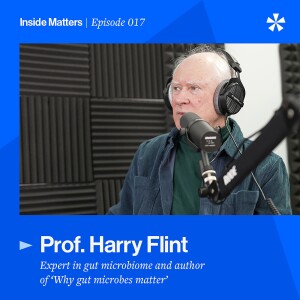
Thursday May 11, 2023
Thursday May 11, 2023
Professor Harry Flint is a world leader in gut microbiome science and Professor Emeritus at the Rowett Institute at the University of Aberdeen. He's known for his book, "Why Gut Microbes Matter" and has two species of gut bacteria named after him: 'HarryFlintia' and 'Flintibacter'.
As part of a research collaboration, Professor Flint helped to identify a combination of six naturally occurring bacteria that work to eradicate a highly contagious form of Clostridium difficile (C. diff). The results of this research illustrated the effectiveness of utilising a mix of bacteria naturally found in the gut to displace C. diff and supershedder microbiota. The research helped develop a standardised mixture treatment for FMT.
Professor Flint began studying ecology at university before switching to genetics, completing his PhD in this field. He then worked as a lecturer for 6 years and then came back to Edinburgh to start a training fellowship to learn molecular biology in 1982. His career began at the Rowett Institute in 1985, with a focus on the rumen of animals due to the complexity of the microbiology of that system of digestion.
He joins James in this episode of Inside Matters, the Gut Health Podcast, to chat about his career as he nears retirement, and the ground-breaking research into the complex universe of the gut microbiome. They cover a variety of topics including the importance of the digestive system of rumens, symbiosis in living organisms and dive into the different levels founds in the gut's microbiome.
TIMESTAMPS:
00:00:00 Intro00:00:26 How did you get into the field of the microbiome00:04:07 What was known of the rumen in the 80s00:08:20 The discovery of key gut bacteria00:10:07 What's the story with termites?00:12:23 Does every living thing have symbiosis?00:14:31 How diverse is the rumen?00:17:00 Transition into human gut research00:19:29 In the 90s what was known of the gut biome?00:22:07 The different levels of the gut microbiome00:26:19 The importance of starch for the microbiome00:30:08 What is a keystone species and how many?00:35:11 What is an enterotype?00:37:56 What is prevotella?00:41:12 Should everyone have a fibre supplement?00:44:58 Does going plant-based improve overall health?00:47:29 Why are the microbes in our gut in the first place?00:51:08 The uniqueness of each human's microbiome00:56:27 10 functional groups found in human stool?00:59:11 Are there disease states with all functional groups?01:02:45 Breast-fed babies with less biome diversity?01:07:39 Important metabolites from the biome01:11:16 What determines ph balance in the biome?01:13:29 What still needs to be characterised in the biome?01:18:51 Do gut bacteria have a form of consciousness?01:24:23 Will AI help gut biome research advance?01:28:03 What about fungi in the gut?01:29:38 What should a healthy microbiome look like?
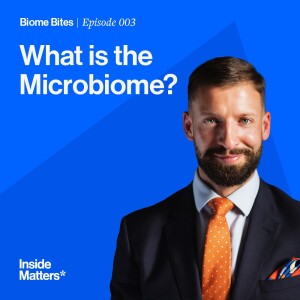
Thursday Apr 27, 2023
Thursday Apr 27, 2023
Dr James McIlroy breaks down the terminology and science surrounding the wonderful world of your gut microbiome, including explaining terms like "microbiota" and how your gut interacts with your immune system, and the ongoing research into the role your microorganisms in your gut with health and well-being.
Watch the video on YouTube - https://youtu.be/_g3QGjHLC98
00:00:00 Introduction and welcome00:00:26 What does the term “microbiome” mean?00:01:34 Is the microbiome just limited to our guts?00:02:27 What’s the scale and scope of our gut’s microbiome?00:03:36 The role of genes in the microbiome and the role they can play in our health00:04:32 What is the microbiota?00:05:16 What is the composition of microorganisms in the microbiome?00:06:46 Tools and techniques for understanding the components of the microbiome are improving00:08:18 What does the microbiome actually do in terms of health?00:09:30 How changing the microbiome may positively impact IBS00:09:53 How might the microbes in the gut communicate with the brain?00:10:39 Does lack of gut microbiome diversity lead to negative health outcomes?00:12:07 How can you change your gut microbiome?
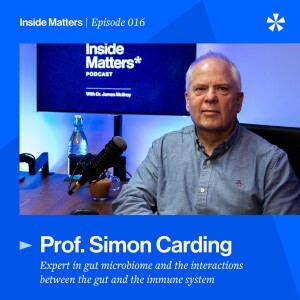
Thursday Apr 13, 2023
Thursday Apr 13, 2023
Learn more about Inside Matters - https://insidematters.health/
Professor Simon Carding is Group Leader at the Quadram Institute and is a Professor of Mucosal Immunology at the University of East Anglia.
Professor Carding's research covers a broad area of gut biology including epithelial cell physiology, mucus and glycobiology, mucosal immunology, commensal microbiology, foodborne bacterial pathogens, and mathematical modelling and bioinformatics. The success of this programme has led to the establishment of the Gut Microbes and Health research programme that is integral to the research agenda of The Quadram Institute.
In this episode, Dr McIlory chats with Professor Carding about his journey into the field of the gut microbiome and they discuss some of the ground-breaking ways his research is revealing the connection between gut health and debilitating conditions such as Parkinson's Disease, Alzheimer's and ME. They also cover the topics of how to ensure good gut health while debunking some popular myths on the topic.

Thursday Mar 30, 2023
Thursday Mar 30, 2023
Learn more about Inside Matters - https://insidematters.health/
In this week’s episode, James has a lively discussion with Dominic Falcão about science, new technologies, starting and securing funding for tech companies and their personal philosophies and outlooks when it comes to development.
Dominic is a co-founder of Deep Science Ventures (DSV), a company that focuses on four key outcomes: restorative cultivation, scaling intelligence, reversing global heating and curative therapeutics.
He previously led Imperial College London’s science startup programme: worked with over 200 student companies, and supported a fraction of these to raise over £25m in funding within 3 years.
Dom admits to being obsessed with building new companies to solve the climate crisis, from carbon-neutral fuels and negative emissions technologies to market-side interventions to funnel more finance profitably into climate solutions. Via DSV, they are championing the diversity of background and vocation of focus in STEM education, starting with a global, diversity-led venture-focused science PhD programme.
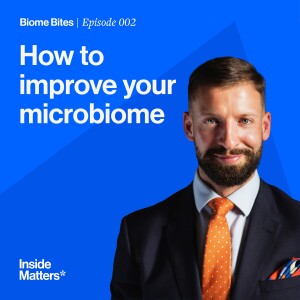
Thursday Mar 16, 2023
Thursday Mar 16, 2023
In episode two of Biome Bites James provides an overview of how to master your microbiome. Often asked how you can improve your microbiome diversity and gut health, James covers a wide range of topics including microbiome-friendly eating and how the food you eat is processed by the gut, probiotics, mindset and easy lifestyle changes you can make to improve your microbiome.
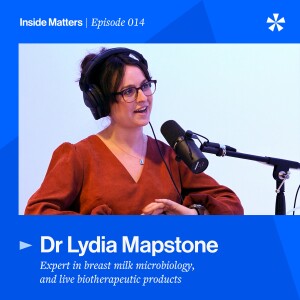
Thursday Mar 02, 2023
Thursday Mar 02, 2023
Learn more about this episode's guest and the topics discussed - https://insidematters.health/
Dr Mapstone is co-founder and CEO at BoobyBiome, a biotechnology company developing live biotherapeutic products to improve and protect infant health. BoobyBiome are seeking to achieve this by rationally designing microbial therapeutics from the beast milk microbiome. Dr Mapstone holds a PhD in Synthetic Biology from UCL.






